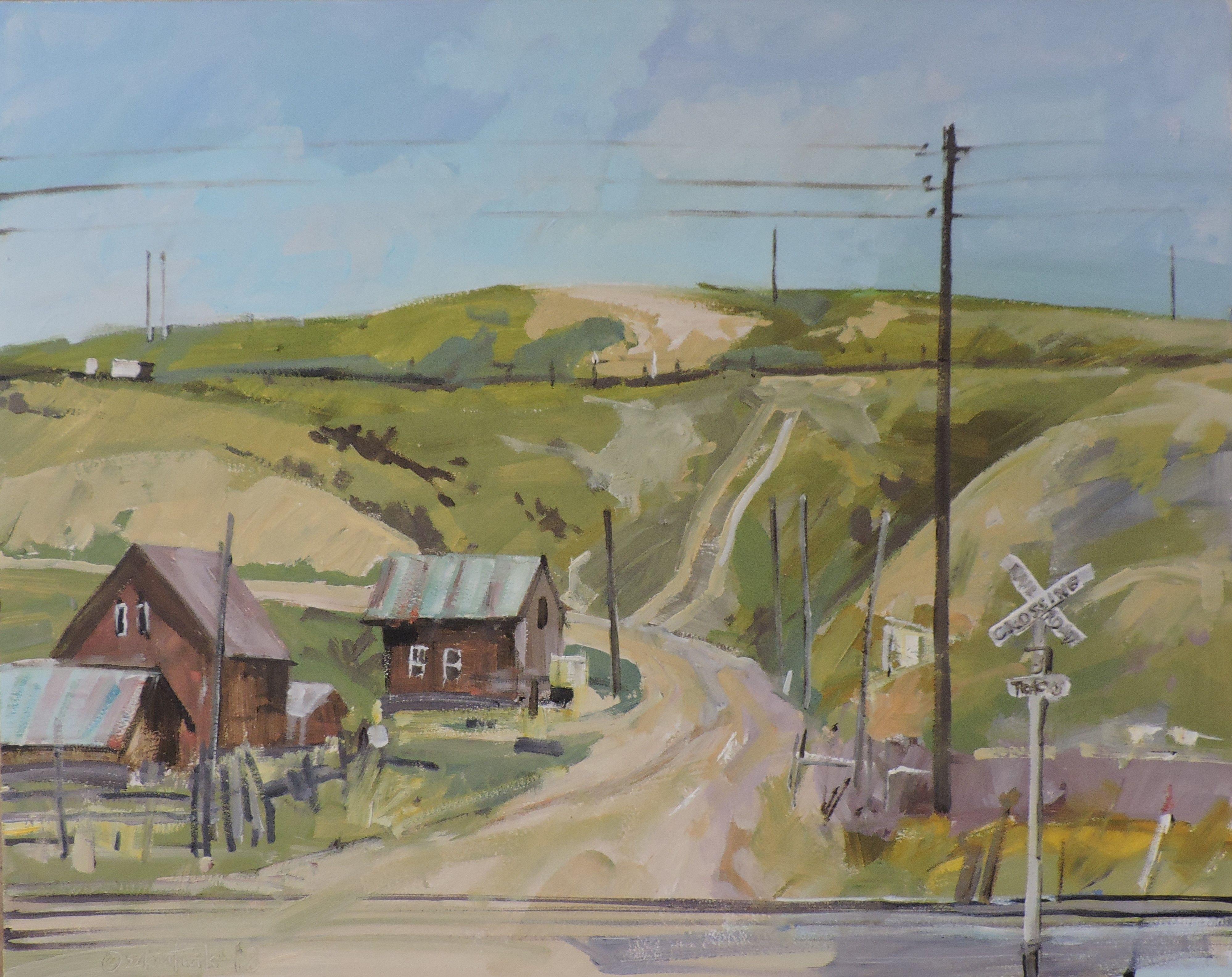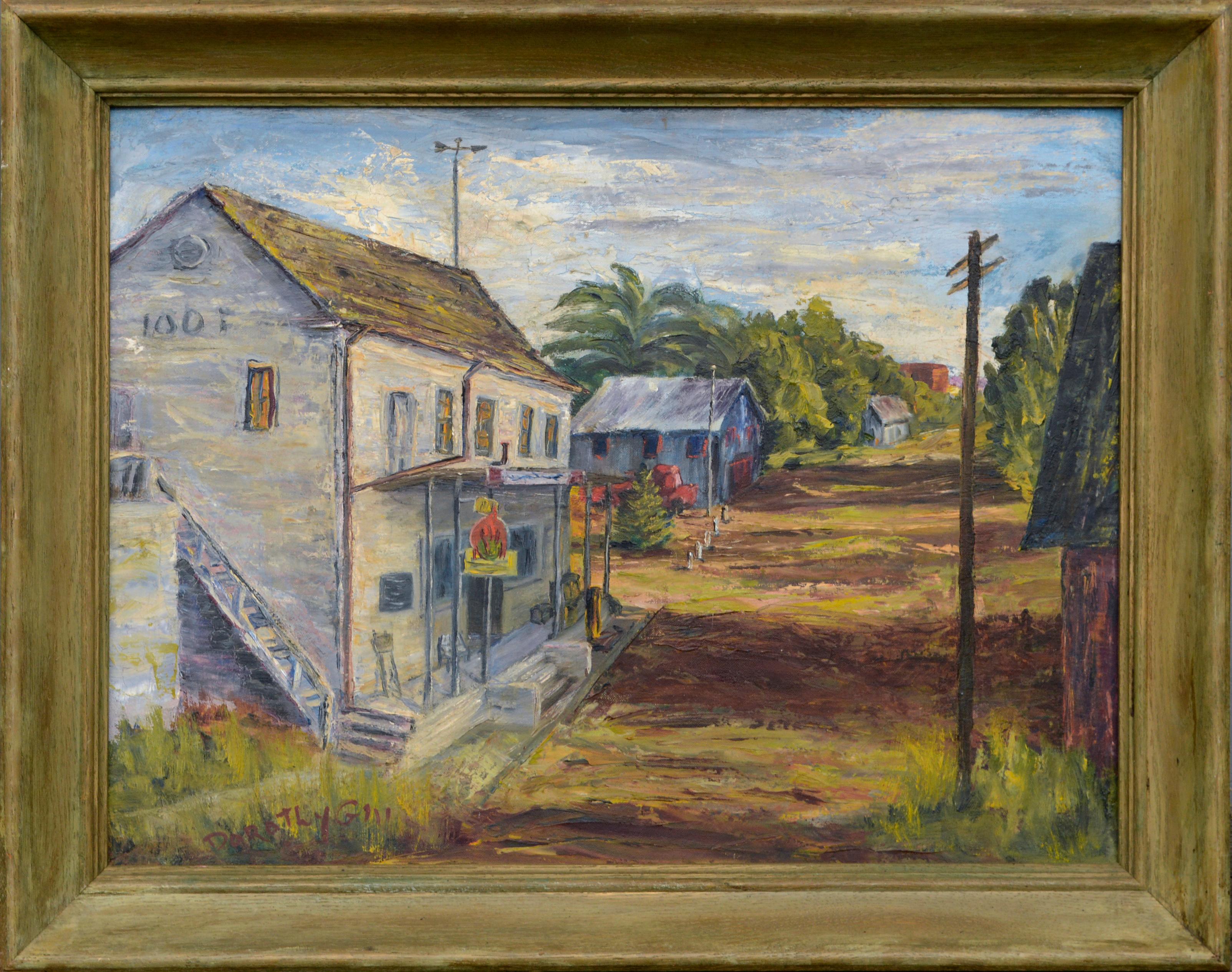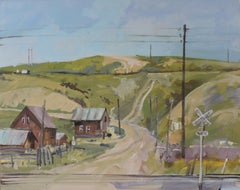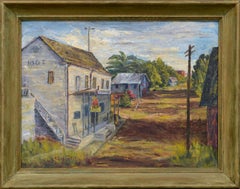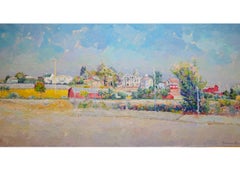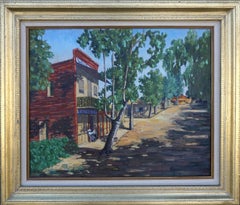Items Similar to Alvarado Railroad Crossing
Want more images or videos?
Request additional images or videos from the seller
1 of 10
Clifford HolmesAlvarado Railroad Crossingc.1950
c.1950
$650
£486.52
€562.17
CA$901.33
A$1,009.61
CHF 524.88
MX$12,466.64
NOK 6,686.62
SEK 6,321.15
DKK 4,195.25
Shipping
Retrieving quote...The 1stDibs Promise:
Authenticity Guarantee,
Money-Back Guarantee,
24-Hour Cancellation
About the Item
This artwork titled "Alvarado Railroad Crossing" c.1950 is an oil painting on canvas by noted California artist Clifford Holmes 1876-1963. It is signed at the lower left corner by the artist. The canvas size is 20 x 24 inches. It is in excellent condition.
About the artist:
Clifford Holmes, noted California artist. The artist is a descendent of early California pioneer families and is a former member of the Art League. Among the founders of the Oakland Art Association, he served on its board and that of the Society of Western Artists. He also is a member of the American Artists Professional League of New York. Holmes works in a variety of media and subjects, and he is represented in many galleries and private collections. Holmes lived in Hayward and “is past president of the Santa Cruz Art League and Hayward Art Association, and is one of the founders of the Oakland Art Association, a member of Society of Western Artists, president of Diablo Art Association of Walnut Creek, and is on the California State Fair Art Advisory Board. Holmes, who did still life, landscapes and portraits in oils, water colors and pastels, has exhibited at Oakland Art Museum, de Young Museum, Rosicrucian Museum, Crocker Art Gallery, University of Redlands, University of Santa Clara. He has received numerous awards. He says he obtained much of his art education from a close study of famous works of art in museums in this country and Europe. He is a graduate of University of Redlands and also has studied at San Jose State, San Francisco State and Sacramento State College. Clifford Holmes colorful paintings and watercolors are sought by art collectors nationwide.
- Creator:Clifford Holmes (1876 - 1963)
- Creation Year:c.1950
- Dimensions:Height: 20 in (50.8 cm)Width: 24 in (60.96 cm)Depth: 0.75 in (1.91 cm)
- Medium:
- Movement & Style:
- Period:
- Condition:
- Gallery Location:San Francisco, CA
- Reference Number:Seller: cli/alv/rai/011stDibs: LU66639650192
About the Seller
5.0
Platinum Seller
Premium sellers with a 4.7+ rating and 24-hour response times
Established in 1999
1stDibs seller since 2017
805 sales on 1stDibs
Typical response time: 1 hour
- ShippingRetrieving quote...Shipping from: San Francisco, CA
- Return Policy
Authenticity Guarantee
In the unlikely event there’s an issue with an item’s authenticity, contact us within 1 year for a full refund. DetailsMoney-Back Guarantee
If your item is not as described, is damaged in transit, or does not arrive, contact us within 7 days for a full refund. Details24-Hour Cancellation
You have a 24-hour grace period in which to reconsider your purchase, with no questions asked.Vetted Professional Sellers
Our world-class sellers must adhere to strict standards for service and quality, maintaining the integrity of our listings.Price-Match Guarantee
If you find that a seller listed the same item for a lower price elsewhere, we’ll match it.Trusted Global Delivery
Our best-in-class carrier network provides specialized shipping options worldwide, including custom delivery.More From This Seller
View AllTolumne, California
By Clifford Holmes
Located in San Francisco, CA
This artwork titled "Tolumne, California" c.1950 is an oil painting on canvas by noted California artist Clifford Holmes 1876-1963. It is signed at the lower right corner by the arti...
Category
Mid-20th Century American Impressionist Figurative Paintings
Materials
Oil
The Old Farm, California
By Clifford Holmes
Located in San Francisco, CA
This artwork "The Old Farm" c.1950 is an oil painting on canvas by noted California artist Clifford Holmes 1876-1963. It is signed at the lower left corne...
Category
Mid-20th Century American Impressionist Landscape Paintings
Materials
Oil
The Bridge House
By Clifford Holmes
Located in San Francisco, CA
This artwork titled "The Bridge House" c.1950 is an oil painting on canvas by noted California artist Clifford Holmes 1876-1963. It is inscribed "Clifford Holmes, The Bridge House" o...
Category
Mid-20th Century American Impressionist Landscape Paintings
Materials
Oil
The Corner Store, Near Mendocino
By Clifford Holmes
Located in San Francisco, CA
This artwork titled "The Corner Store, Near Mendocino" c.1950 is an oil painting on canvas by noted California artist Clifford Holmes 1876-1963.Signed at the lower right corner by th...
Category
Mid-20th Century American Impressionist Landscape Paintings
Materials
Oil
Ponderosa, California, in the Afternoon
By Clifford Holmes
Located in San Francisco, CA
This artwork titled "Ponderosa, California, in the Afternoon" c.1950 is an oil painting on canvas by noted California artist Clifford Holmes 1876-1963. It is signed at the lower righ...
Category
Mid-20th Century American Impressionist Landscape Paintings
Materials
Oil
Old Barn, Near Auburn
By Clifford Holmes
Located in San Francisco, CA
This artwork titled "Old Barn Near Auburn" c.1950 is an oil painting on canvas by noted California artist Clifford Holmes 1876-1963. It is signed at the lower...
Category
Mid-20th Century American Impressionist Figurative Paintings
Materials
Oil
You May Also Like
Railroad Crossing, Painting, Oil on Other
By Richard Szkutnik
Located in Yardley, PA
original en plein air oil on panel :: Painting :: Impressionist :: This piece comes with an official certificate of authenticity signed by the artist :: Ready to Hang: No :: Signed: ...
Category
2010s Impressionist Paintings
Materials
Oil
Vintage Small Town Landscape
Located in Soquel, CA
Scene of a road in a small town by Dorothy Gill (American, 20th Century). Signed "Dorothy Gill" in the lower left corner. Presented in a distressed wood frame. Image size: 18"H x 24"W
Category
1960s American Impressionist Landscape Paintings
Materials
Canvas, Oil, Cardboard
American Impressionist California OLD SANTA CRUZ Street Scene Railroad Painting
By Herman Rose
Located in New York, NY
Herman Rose (1909-2007)
Signed and dated 1989
“Old Santa Cruz from across The Railroad”
Oil on Canvas
15x30 inches unframed
17x32 inches framed
Fischbach Gallery Label
Great Conditio...
Category
1980s American Impressionist Landscape Paintings
Materials
Oil
Wells Fargo Express, Gold Country -- Columbia, California
By Cecil F. Chamberlin
Located in Soquel, CA
Charming oil painting of the Wells Fargo Express Office building in the gold country town of Columbia State Historic Park in Columbia, California by Cecil ...
Category
1950s American Impressionist Landscape Paintings
Materials
Canvas, Oil, Illustration Board
$1,320 Sale Price
20% Off
Gramby Station, Painting, Oil on Wood Panel
By Richard Szkutnik
Located in Yardley, PA
original oil on panel paint in Gramby, Colorado :: Painting :: Impressionist :: This piece comes with an official certificate of authenticity signed by the artist :: Ready to Hang: N...
Category
21st Century and Contemporary Impressionist Paintings
Materials
Oil
"Train Station, " Max Kuehne, Industrial City Scene, American Impressionism
By Max Kuehne
Located in New York, NY
Max Kuehne (1880 - 1968)
Train Station, circa 1910
Watercolor on paper
8 1/4 x 10 1/4 inches
Signed lower right
Provenance:
Private Collection, Illinois
Max Kuehne was born in Halle, Germany on November 7, 1880. During his adolescence the family immigrated to America and settled in Flushing, New York. As a young man, Max was active in rowing events, bicycle racing, swimming and sailing. After experimenting with various occupations, Kuehne decided to study art, which led him to William Merritt Chase's famous school in New York; he was trained by Chase himself, then by Kenneth Hayes Miller. Chase was at the peak of his career, and his portraits were especially in demand. Kuehne would have profited from Chase's invaluable lessons in technique, as well as his inspirational personality. Miller, only four years older than Kuehne, was another of the many artists to benefit from Chase's teachings. Even though Miller still would have been under the spell of Chase upon Kuehne's arrival, he was already experimenting with an aestheticism that went beyond Chase's realism and virtuosity of the brush. Later Miller developed a style dependent upon volumetric figures that recall Italian Renaissance prototypes.
Kuehne moved from Miller to Robert Henri in 1909. Rockwell Kent, who also studied under Chase, Miller, and Henri, expressed what he felt were their respective contributions: "As Chase had taught us to use our eyes, and Henri to enlist our hearts, Miller called on us to use our heads." (Rockwell Kent, It's Me O Lord: The Autobiography of Rockwell Kent. New York: Dodd, Mead and Co., 1955, p. 83). Henri prompted Kuehne to search out the unvarnished realities of urban living; a notable portion of Henri's stylistic formula was incorporated into his work.
Having received such a thorough foundation in art, Kuehne spent a year in Europe's major art museums to study techniques of the old masters. His son Richard named Ernest Lawson as one of Max Kuehne's European traveling companions. In 1911 Kuehne moved to New York where he maintained a studio and painted everyday scenes around him, using the rather Manet-like, dark palette of Henri.
A trip to Gloucester during the following summer engendered a brighter palette. In the words of Gallatin (1924, p. 60), during that summer Kuehne "executed some of his most successful pictures, paintings full of sunlight . . . revealing the fact that he was becoming a colorist of considerable distinction." Kuehne was away in England the year of the Armory Show (1913), where he worked on powerful, painterly seascapes on the rocky shores of Cornwall. Possibly inspired by Henri - who had discovered Madrid in 1900 then took classes there in 1906, 1908 and 1912 - Kuehne visited Spain in 1914; in all, he would spend three years there, maintaining a studio in Granada. He developed his own impressionism and a greater simplicity while in Spain, under the influence of the brilliant Mediterranean light. George Bellows convinced Kuehne to spend the summer of 1919 in Rockport, Maine (near Camden). The influence of Bellows was more than casual; he would have intensified Kuehne's commitment to paint life "in the raw" around him.
After another brief trip to Spain in 1920, Kuehne went to the other Rockport (Cape Ann, Massachusetts) where he was accepted as a member of the vigorous art colony, spearheaded by Aldro T. Hibbard. Rockport's picturesque ambiance fulfilled the needs of an artist-sailor: as a writer in the Gloucester Daily Times explained, "Max Kuehne came to Rockport to paint, but he stayed to sail." The 1920s was a boom decade for Cape Ann, as it was for the rest of the nation. Kuehne's studio in Rockport was formerly occupied by Jonas Lie.
Kuehne spent the summer of 1923 in Paris, where in July, André Breton started a brawl as the curtain went up on a play by his rival Tristan Tzara; the event signified the demise of the Dada movement. Kuehne could not relate to this avant-garde art but was apparently influenced by more traditional painters — the Fauves, Nabis, and painters such as Bonnard. Gallatin perceived a looser handling and more brilliant color in the pictures Kuehne brought back to the States in the fall. In 1926, Kuehne won the First Honorable Mention at the Carnegie Institute, and he re-exhibited there, for example, in 1937 (Before the Wind). Besides painting, Kuehne did sculpture, decorative screens, and furniture work with carved and gilded molding. In addition, he designed and carved his own frames, and John Taylor Adams encouraged Kuehne to execute etchings. Through his talents in all these media he was able to survive the Depression, and during the 1940s and 1950s these activities almost eclipsed his easel painting. In later years, Kuehne's landscapes and still-lifes show the influence of Cézanne and Bonnard, and his style changed radically.
Max Kuehne died in 1968. He exhibited his work at the National Academy of Design, the Art Institute of Chicago, the Carnegie Institute in Pittsburgh, the Memorial Art Gallery of the University of Rochester, and in various New York City galleries. Kuehne's works are in the following public collections: the Detroit Institute of Arts (Marine Headland), the Whitney Museum (Diamond Hill...
Category
1910s American Impressionist Landscape Drawings and Watercolors
Materials
Paper, Watercolor
More Ways To Browse
Toshio Iezumi
Tuileries Garden Photography
Tutu Skirt Alex Sher
Tyler Shields Book
Ubu Miro Lithograph
Ulla Stina Wikander
Used Motor Scooters
Vidal Quadras
Vintage Air Force Recruiting Posters
Vintage American Football Posters
Vintage Circus Clothing
Vintage Continental Airlines Poster
Vintage Dracula Art
Vintage F1 Poster Art Posters
Vintage German Shepherd Prints
Vintage Guyana
Vintage Ireland Travel Posters
Vintage Life Raft
